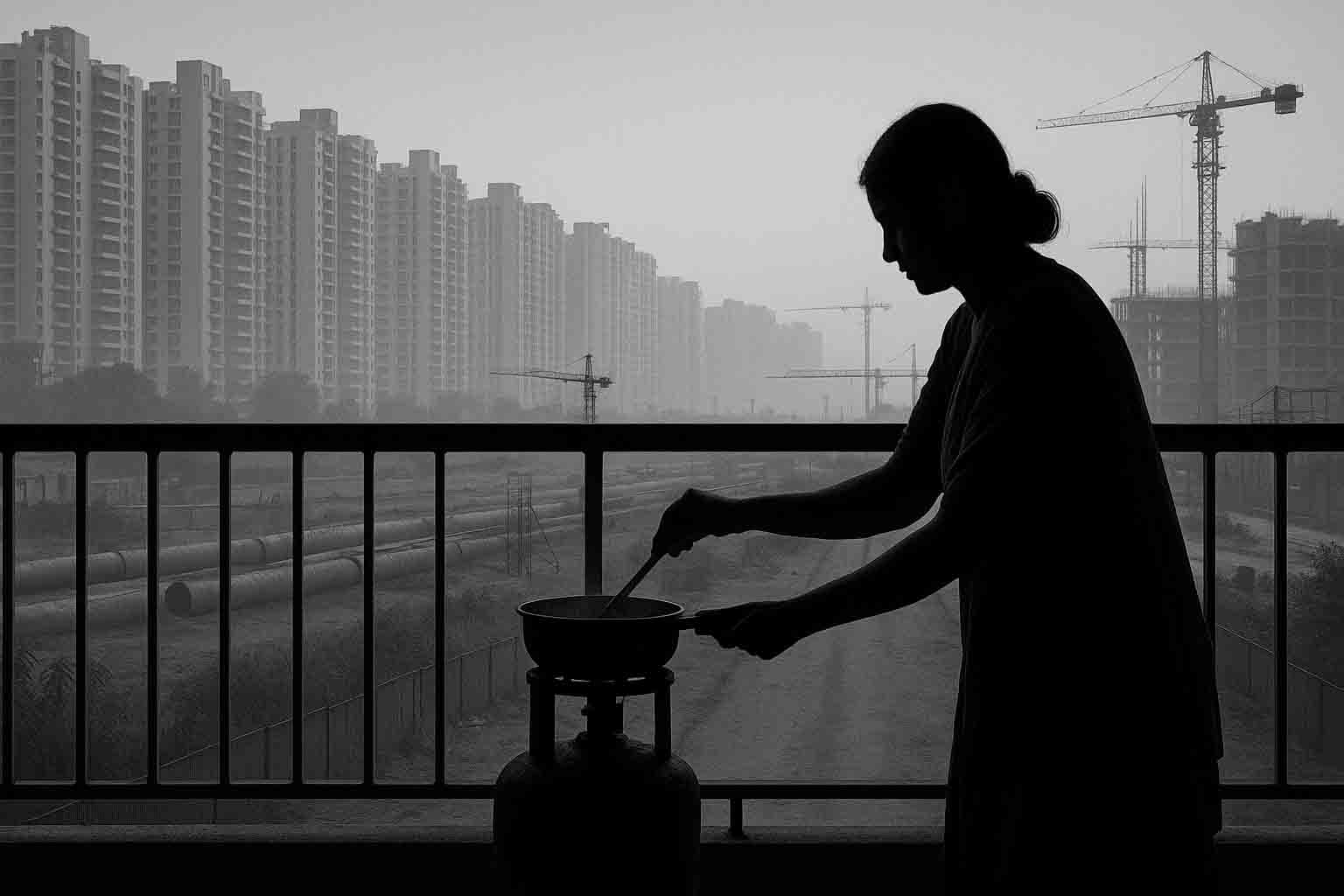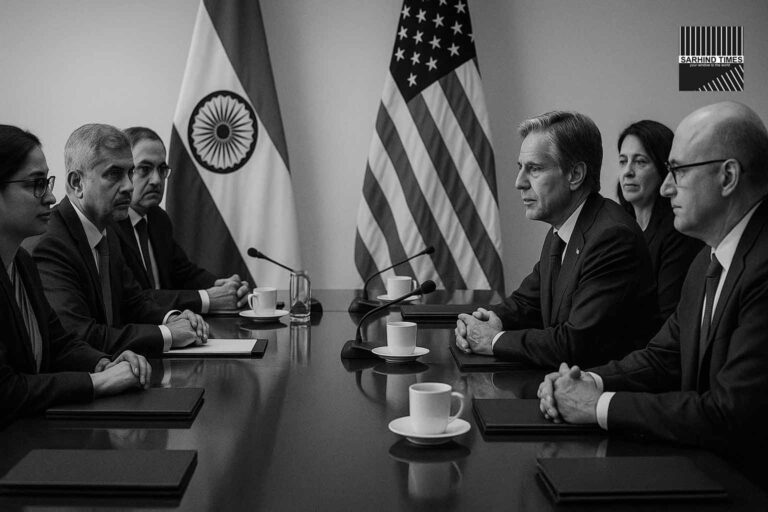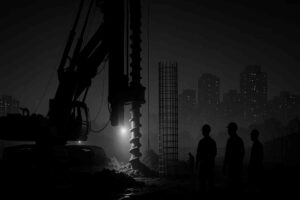Gurugram | October 7, 2025 | Sarhind Times Urban Desk
Even as the glittering towers of the Dwarka Expressway corridor promise luxury living and modern infrastructure, one of the most basic utilities—piped natural gas (PNG)—remains elusive for nearly 2 lakh residents. Years after making security deposits and connection payments, families continue to depend on LPG cylinders, citing a mix of corporate dispute, regulatory inertia, and weak coordination between city agencies and licensed operators.
Households Stuck Between Promises and Paperwork
Along the length of the Dwarka Expressway, which cuts through sectors 99 to 115 of Gurugram, hundreds of newly occupied apartments now echo a common complaint: “We paid for gas, but there’s no gas.”
RWAs from societies such as ATS Triumph, DLF Garden City, Sobha City, Raheja Vanya, and Hero Homes told Sarhind Times that residents had cleared PNG connection fees over 12–18 months ago. Many developers had showcased “PNG-ready” infrastructure in brochures, complete with metering ducts and control panels. Yet, residents still rely on LPG cylinders—an anomaly in a region marketed as Haryana’s most modern residential belt.
“I paid ₹8,000 in 2023 for PNG registration, and despite multiple reminders, we’re told the company hasn’t received the final go-ahead from the regulator,” said Amit Sharma, a resident of Sector 109. “Meanwhile, we’re spending more on cylinder refills and facing safety risks.”
The Core Issue: Licence Demarcation Dispute
At the heart of the deadlock lies a jurisdictional overlap between two gas distribution companies operating under overlapping city gas distribution (CGD) licenses.
The Haryana City Gas (HCG) and Indraprastha Gas Limited (IGL) have both historically laid pipelines or claimed rights over parts of the Dwarka Expressway corridor. According to regulatory filings and previous Petroleum and Natural Gas Regulatory Board (PNGRB) communications, certain sub-sectors fall within “grey zones” where network ownership remains unclear due to boundary revisions and late demarcation.
Officials from one operator, speaking anonymously, said:
“The demarcation issue dates back to changes in the Gurugram district boundary and Dwarka Expressway’s realignment. Without PNGRB’s formal notification clarifying network ownership, we can’t initiate metering and billing legally.”
PNGRB, the national regulator, had earlier directed both entities to submit revised maps and reach a coordination agreement. However, insiders say bureaucratic back-and-forth and local-level jurisdiction disputes between Gurugram and adjoining Delhi sectors slowed implementation.
Impact: Safety, Costs, and Consumer Inconvenience
While the dispute sounds bureaucratic, its impact is tangible. Residents cite:
- Cylinder storage in high-rises — Many towers store LPG cylinders in balconies or utility areas, posing safety risks.
- Escalating costs — Repeated cylinder refills in large families cost more than piped gas, eroding promised savings.
- Builder-resident disputes — Builders advertise PNG-ready flats but can’t commission service until licenses clear.
- Inconvenience for elderly and tenants — Manual refilling cycles burden elderly residents or tenants who move frequently.
- Delayed occupancy certifications — In some cases, authorities withhold final NOCs for incomplete utility activation.
Fire department officials confirmed that cylinder use in high-rise clusters increases incident risk, especially during festive months. “Cylinders are safe if used responsibly, but in tower basements or crowded balconies, leakage can be catastrophic,” said an official under anonymity.
Resident Associations Demand Accountability
Resident Welfare Associations have banded together, sending joint letters to PNGRB, Haryana Urban Development Authority (HSVP), and GMR Infrastructure (overseeing Dwarka E-way civil works).
“It’s not just a corporate tussle. It’s consumer rights,” said Poonam Bhardwaj, President of the Raheja Vanya RWA. “Families have paid thousands. Gas pipelines run under our roads, but service isn’t activated because two companies can’t decide who owns the customer.”
The Gurugram Citizens Council (GCC), a civic advocacy group, demanded a ward-wise activation calendar published on official portals. They also urged the regulator to impose penalties for missed service deadlines and mandate temporary LPG subsidy relief in affected societies.
Authorities’ Response: ‘Under Review’
Officials at the PNGRB and Haryana Urban Local Bodies Department told Sarhind Times that coordination meetings are “ongoing.”
“Technical teams have mapped the exact boundaries. Once legal clarity is issued, permissions for trenching, jointing, and commissioning will follow. Residents can expect phased activation,” said a senior state energy officer.
Meanwhile, Gurugram’s district administration said it is monitoring the matter given rapid population growth along the expressway. “Our concern is safety. We’ve directed fire and RWA coordination units to inspect cylinder storage and report hazards,” said Deputy Commissioner’s office sources.
Gas Companies’ Stand
Both distribution companies issued guarded statements.
Indraprastha Gas Ltd (IGL):
“Work on primary pipeline infrastructure is largely complete. Service connections will begin post-clearance of demarcation. We remain committed to safe, reliable PNG supply.”
Haryana City Gas (HCG):
“Legal clarifications and inter-company coordination are in progress. Backend network testing is ongoing. Activation will be immediate upon regulatory nod.”
Industry analysts note that such disputes are not new—similar overlaps have delayed PNG rollout in parts of Gurgaon-Manesar belt earlier. However, the Dwarka Expressway corridor’s high-density profile magnifies the impact.
The Corridor in Context: A City Within a City
Dwarka Expressway—an eight-lane elevated corridor connecting Delhi’s Dwarka to Gurugram’s NH-48—has become the fastest-growing residential belt in NCR. Estimates suggest nearly 1.5–2 lakh people will move into this zone by end-2026.
Developers advertise “world-class living,” with amenities including 24×7 power backup, recycled water, and PNG pipelines. Yet, as residents point out, the backbone of safety—gas, sewage, and waste management—lags behind glass façades.
Urban planners caution that infrastructure lag could undermine livability. “Expressway corridors often focus on asphalt, not amenities,” said Dr. Sameer Dhillon, urban policy expert. “Dwarka E-way has the potential to be NCR’s benchmark, but basic utilities must be synchronized—power, gas, mobility, and emergency systems.”
Regulatory Labyrinth: How PNG Licenses Work
To understand the deadlock, one must understand how PNG networks operate.
- PNGRB issues exclusive city gas distribution (CGD) licenses for specific “GA” (Geographical Areas).
- Companies invest in pipelines, pressure regulators, meters, and safety systems under a 25-year license.
- Any overlap or realignment of city boundaries requires mutual consent or fresh mapping by PNGRB.
- Disputes often arise when new infrastructure (like expressways) cuts through older district demarcations, changing control zones.
Unless both licensees sign an operational boundary agreement, activation cannot proceed to billing—leaving customers stranded between companies.
Environmental & Safety Aspects
PNG is cleaner, safer, and more efficient than LPG cylinders, producing 25% less carbon dioxide per unit energy. Extended delay in rollout impacts both household safety and emission targets.
The Ministry of Petroleum & Natural Gas (MoPNG) had set a target to expand PNG to 10 crore households nationwide by 2030. Gurugram’s lag therefore dents national urban energy access metrics.
Environmental groups argue that the city’s eco-footprint could shrink if PNG replaces LPG and reduces cylinder transport emissions. “Every kilometer of pipeline not used adds diesel truck movement for cylinder delivery,” said an activist from CleanFuel India Network.
The Human Angle: A Daily Struggle
Beyond regulatory jargon, it’s about routines disrupted.
- Families queue for cylinder replacements.
- Tenants lose security deposits to agencies promising connections “next month.”
- Elderly residents struggle to manage heavy cylinders.
Nidhi Verma, resident of Sector 110A, summed it up:
“Every morning, we wake up to construction dust, power cuts, and now we’re refilling cylinders in towers that promised green energy. Our kitchens symbolize the gap between Gurugram’s image and its infrastructure reality.”
Possible Solutions on the Horizon
Experts recommend a three-tier response:
- Regulatory Intervention – PNGRB to issue a one-time directive clarifying Dwarka E-way boundaries within 30 days.
- Joint Operating Committee – Both gas companies to form a joint technical cell supervised by district administration for phased rollout.
- Public Communication Portal – Live dashboards listing society-wise connection status, ward supervisors, complaint tracking.
If followed, sources estimate that at least 60% of pending households could get PNG by mid-2026.
Citizen Awareness: Know Your Rights
Residents can:
- Register grievances with PNGRB (Consumer Affairs Division) online.
- Request status updates via the Right to Information (RTI) Act from respective gas companies.
- Approach District Consumer Redressal Forum for undue delay or deficiency of service after payment.
- Seek RWA legal aid cells for collective representation.
Legal experts note that payment receipt and unfulfilled service constitute a contractual lapse if timelines were promised in writing.
Conclusion: Gasless Growth and the Need for Accountability
The Dwarka Expressway corridor stands as a paradox—India’s most aspirational urban stretch, yet gasless kitchens inside its skyscrapers. For a city striving toward smart living and sustainability, such service gaps dilute credibility.
The immediate need is not just pipeline completion—it is coordination, transparency, and urgency. Every delayed connection represents a family waiting for safety, convenience, and trust restored in governance.
#Gurgaon #DwarkaExpressway #PNG #ConsumerRights #UrbanInfra
#EnergyAccess #Utilities #Haryana #SarhindTimes
























+ There are no comments
Add yours